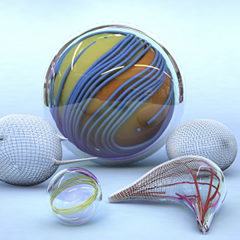» Soft & Bio Seminars
» Euler-Plateau
» Bristle-Bots
|
|
|
Our Research
|
|
Active Matter

Understanding the mechanics of living systems at the cellular and sub-cellular scale is probably one of the
most fascinating challenge of modern physics. These systems (i.e. the cell cytoskeleton and its components)
have much in common with soft condensed matter systems (i.e. liquid crystals, amphiphiles, colloids etc.),
but in addition they exibith a variety of behaviors that don't appear in the more physics-friendly inanimated
matter and that are crucial for biological functions. The paradigm of "active matter" has had notable successes
over the past decade in describing self-organization in a surprisingly broad class of biological and bio-inspired
systems: from flocks of starlings, down to bacterial colonies and the cell cytoskeleton. Active systems are generic
non-equilibrium assemblies of anisotropic components that are able to convert stored or ambient energy into motion.
Due to the interplay between internal activity and the interactions between the constituents, these systems exhibit
a spectacular variety of collective behaviors which are entirely self-driven and do not require a central control
mechanism.
|
|
|
Selected References
Topology and dynamics of active nematic vesicles, Science 345, 1135 (2014).
Spontaneous division and motility in active nematic droplets, Phys. Rev. Lett. 112, 147802 (2014).
|
|
|
|
Collective behavior

Collective behavior describes the ability of groups of living organisms to move coherently in space and time.
This is ubiquitous among living systems: it occurs in sub-cellular systems, bacteria, insects, fish,
birds and in general in nearly any group of individuals endowed with the ability to move and sense. This
spectacular example of robustness has inspired science and technology in a two-fold way: on one hand scientists
have focused their efforts in understanding the origin of a collective behavior found in systems of such an
astonishing diversity; on the other hand technologists have envisioned the possibility of implementing this
form of social organization that spontaneously arises in living systems to construct swarms of devices that
can work independently and yet collectively towards a common goal. One of the fundamental questions in the
study of collective behavior is what mechanism triggers the switch from disordered to organized behavior and
whether this is system specific.
|
|
|
Selected References
The dynamics of sperm cooperation in a competitive environment, Proc. R. Soc. B 281, 20140296 (2014).
Swarming, swirling and stasis in sequestered bristle-bots, Proc. R. Soc. A 469, 20120637 (2013).
|
|
|
|
Polymorphism and multistability in the micro and macro world

Understanding the origin of shape in structures at various length scales is a central goal across many areas
of science and engineering. Often, the shape is dictated by the balance of competing forces simultaneously
acting on a system, such as the pressure difference across the interface between two fluids and its surface
tension. These systems are, by their nature, polymorphic as they can be arranged in different conformations
by tuning their geometric and mechanical properties. In other systems, preexisting stresses accumulated during
growth or spontaneous curvature conspire with the elastic forces to mold nontrivial shapes, not rarely giving
rise to multiple stable equilibria. We investigate polymorphism and multistability in macroscopic
structures, such as liquid or elastic films, as well as in biological materials and cells.
|
|
|
Selected References
Softly constrained films, Soft Matter 9, 8121 (2013).
Polymorphism and bistability in adherent cells, Soft Matter 9, 5251 (2013).
|
|
|
|
Defects and geometry in soft materials

A central topic of our research is the study of the interplay between order and geometry in soft
matter systems, with particular emphasis on the characterization of crystalline structures on two-dimensional
curved surfaces. Crystalline surfaces appear in nature in a variety of systems such as biological membranes,
self-organizing amphiphilic vesicles, viral and bacteriophage capsids and carbon macromolecules. Topological
defects frequently appear in the lowest energy states of ordered systems on curved surface as the consequence
of the spatial curvature. Defective regions are natural places for biological activity, chemical linking,
unusual elastic response and proliferation of disorder. Our work employs techniques of theoretical elasticity
and differential geometry to predict the lowest energy configuration of topological defects on substrates
of different kind. To complement the analytical work, we use of large scale numerical simulations and
develop new serial and parallel algorithms for the global optimization of molecular clusters.
|
|
|
Selected References
Two-dimensional matter: order, curvature and defects, Adv. Phys. 58, 449 (2009).
Defective ground states of toroidal crystals, Phys. Rev. E 78, 010601(R)(2008).
|
|



